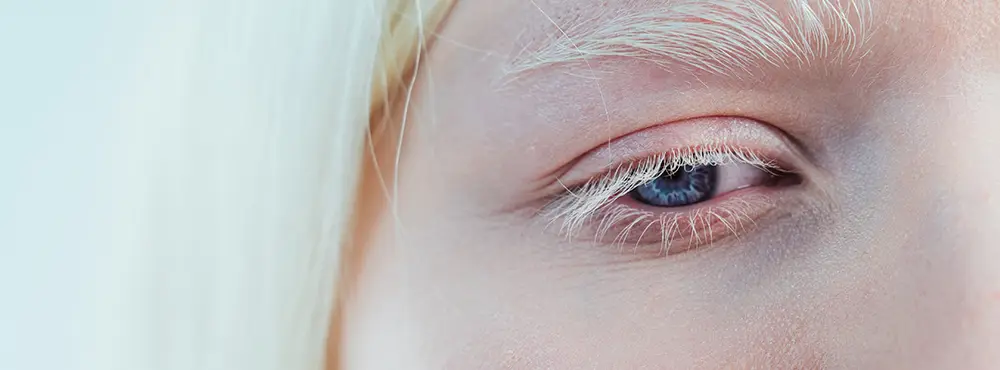
 Offers
Offers-
 Account
Account
-
0
 Favorite
Favorite
-
0
 Basket
Basket



Medically reviewed by Khuram Sarwar, Dispensing Optician at Feel Good Contacts.
Albinism is a rare genetic condition that affects the production of melanin, a kind of pigmentation that determines the colour of the skin, hair and eyes. This is the reason why albino people generally have pale skin tone. Melanin also plays a role in maintaining the health of the optic nerve. They are also prone to the risk of vision loss. Male or female, anyone can be born with this condition. In this article, we will delve into the complexities around albinism, providing insights into its intricacies, underlying causes, far-reaching effects on individuals and the essential resources available to those suffering from this condition.
Albinism is a rare genetic condition in which the pigment responsible for colouring eyes, skin and hair stops producing melanin. People suffering from albinism define themselves as "Albino", derived from the Latin word "Albus", meaning white, implying that people suffering from albinism generally have pale or whitish skin and brown hair.
Albinos also have a high risk of skin cancer in the early years of their lives. This is because of lack of melanin, whose basic function is to shield the skin from the sun's harmful UV rays, making their skin prone to sunburns. Furthermore, lack of melanin can disrupt the seamless vision capabilities of a person.
Albinism is a rarely occurring genetic condition in people across the world, no matter what their gender is, where they come from, their race, ethnicity, and sexuality. In the UK, almost 1:17,000 people suffer from this life-long condition . Not a contagious disease, albinism is a hereditary condition, meaning people are born with it. Although this condition doesn't have a cure, with proper mitigation strategies, one can implement certain coping mechanisms.

Albinism is a condition that occurs when specific genes (melanocytes) responsible for producing and distributing melanin are defective, impacting a person’s vision. This condition typically occurs when both parents carry the genes for albinism, causing a lack of melanin or minimal production. When these genes are changed, it can result in either an absence or a decrease in melanin production. Medical professionals estimate that 1:70 of the population bears these genes.
Genetic variations can lead to various forms of albinism affecting the melanin level of skin, hair and eyes.
Albinism is segregated into four different types.
The primary symptoms of albinism are recognised in the attributes of skin, hair and eyes. Below are some of the symptoms of albinism:
Lighter skin tones can lead to a burning sensation from sun exposure and develop freckles, pink moles and lentigines on the skin.
Although the hair colour changes from white to brown, the colours tend to darken as the affected person ages.
The eye colour tends to change from light blue to shades of brown. The iris becomes sensitive to light due to its inability to protect from the sun's harmful rays. It might appear translucent or red due to low melanin levels.
People coping with albinism often suffer from vision problems, including Strabismus (crossed eyes or walleye), extreme level of myopia (near-sightedness) and hyperopia (farsightedness). Due to underdeveloped optic nerve, people with albinism are visually impaired or have blurred vision.
There is no cure for albinism, but proper mitigation strategies can help alleviate symptoms of the condition to worsen further.
People with albinism can cope with this condition from verified resources and support organisations:
Twenty-two-year-old Leo and his sister, who have been battling albinism, initially struggled to accept this condition. Later, Leo became proud of his unique features and now works as a professional model. Leo’s life is a source of inspiration to albino people with dreams.
Disclaimer: The advice in this article is for informational purposes only and does not replace medical care or an in-person check-up. Please check with an eyecare professional before purchasing any products or remedies. For information on our article review process, please refer to our Editorial Policy.